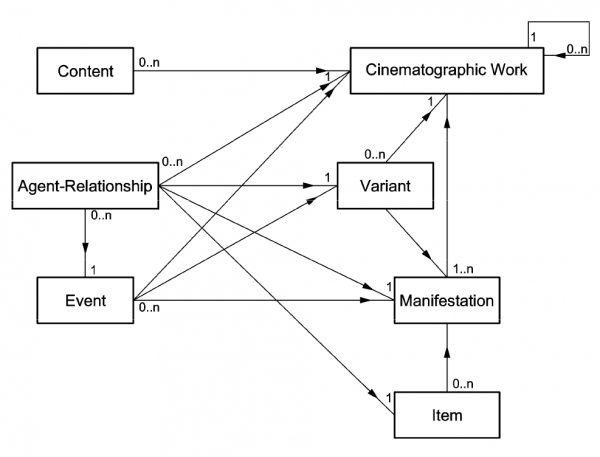|
|
| Line 9: |
Line 9: |
| | [[File:EN15907-ER-diag-CEN.png|600px|center]] | | [[File:EN15907-ER-diag-CEN.png|600px|center]] |
| | | | |
| − | ====Cinematographic Work====
| + | [[EN 15907 Cinematographic Work|Cinematographic Work]] |
| | | | |
| − | Definition from the standard:
| |
| | | | |
| − | {|style="background-color:#C8C8C8"
| |
| − | |
| |
| − | This entity forms the node that relates all variants and manifestations of a moving image work to a common creation. The concept of cinematographic work comprises both the intellectual or artistic content and the process of realisation in a cinematographic medium. Since this process determines the characteristics which are expected to persist in any variant of a cinematographic work, this entity is defined here as the topmost level of description. Characteristics that should remain constant throughout all variants of a cinematographic work include circumstances of the creation process such as date(s) and place(s) of production, most contributions by agents such as directors, screenwriters, production staff and cast members, as well as any statements about the contents. Statements about the extent of a cinematographic work are not defined at this level of description. If a statement about an "original format" is required, then this may be expressed through an associated instance of manifestation labelled with a suitable type name such as "original".
| |
| − |
| |
| − | A cinematographic realisation of a pre-existing non-film work is considered as a cinematographic work. This includes pure performance works such as concerts, original theatre performances, sports events, etc.
| |
| − | Moving images created by use of automatic devices such as surveillance cameras, scientific or medical instruments, etc. can be considered as cinematographic works if they are part of an archive collection or if they have been edited, published or distributed by a known Agent.
| |
| − |
| |
| − | Instances of the Cinematographic Work entity may have one-to-many relationships with instances of Variant and Manifestation and many-to-many relationships with instances of Agent, Event and Content.
| |
| − | |}
| |
| − |
| |
| − | Model:
| |
| − |
| |
| − | {|cellpadding="2" style="border: 1px solid darkgray; background-color:#dbc596"
| |
| − | |- valign="top"
| |
| − | |style="background-color:#8dc5a9"|
| |
| − | Attributes
| |
| − | |style="background-color:#8dc5a9"|
| |
| − | Elements
| |
| − | |style="background-color:#8dc5a9"|
| |
| − | Relationships
| |
| − | |- valign="top"
| |
| − | |
| |
| − | descriptionLevel
| |
| − | |
| |
| − | Identifier (one or more)<br />
| |
| − | Record source (one or more)<br />
| |
| − | Title (zero or more)<br />
| |
| − | Identifying title (one or more)<br />
| |
| − | Country of reference (one or more)<br />
| |
| − | Year of reference (one or more)<br />
| |
| − | Language (zero or more)<br />
| |
| − | Subject terms (zero or more)<br />
| |
| − | Content description (zero or more)
| |
| − | |
| |
| − | HasAgent (zero or more)<br />
| |
| − | HasEvent (zero or more). Targets: Production Event, Award, IPR registration<br />
| |
| − | HasContent (zero or more)<br />
| |
| − | HasAsSubject (zero or more)<br />
| |
| − | HasOtherRelation (zero or more)<br />
| |
| − | HasVariant (zero or more; if zero, then HasManifestation shall have a cardinality of one or more)<br />
| |
| − | HasManifestation (zero or more; if zero, then HasVariant shall have a cardinality of one or more)
| |
| − | |-
| |
| − | |}
| |
| | | | |
| | | | |
